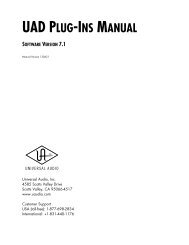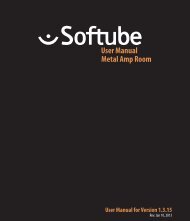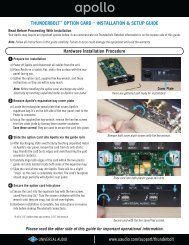Apollo 16 Hardware Manual.pdf - Universal Audio
Apollo 16 Hardware Manual.pdf - Universal Audio
Apollo 16 Hardware Manual.pdf - Universal Audio
You also want an ePaper? Increase the reach of your titles
YUMPU automatically turns print PDFs into web optimized ePapers that Google loves.
Front Panel<br />
This section describes the features and functionality of all controls and visual elements on the <strong>Apollo</strong> <strong>16</strong> front<br />
panel. Note that most front panel functions can be controlled remotely with the Console software application.<br />
1 2 3 4 5 6 7 8<br />
9<br />
MONITOR<br />
METER<br />
HOST<br />
CLOCK<br />
INT<br />
EXT<br />
METER<br />
IN<br />
OUT<br />
RATE<br />
44.1<br />
48<br />
88.2<br />
96<br />
176.4<br />
192<br />
1 2 3 4 5 6 7 8<br />
C<br />
0<br />
-3<br />
-6<br />
-9<br />
-12<br />
-15<br />
-18<br />
-21<br />
-27<br />
9 10 11 12 13 14 15 <strong>16</strong><br />
C<br />
0<br />
-3<br />
-6<br />
-9<br />
-12<br />
-15<br />
-18<br />
-21<br />
-27<br />
1 2<br />
C<br />
0<br />
-3<br />
-6<br />
-9<br />
-12<br />
-15<br />
-18<br />
-21<br />
-27<br />
METER I/O<br />
POWER<br />
OFF<br />
(1) Meter<br />
The METER button determines which signals, either input or output, are displayed by the Channel Meters (4).<br />
Push the switch to toggle the meter display state between Input and Output. The current meter state is displayed<br />
by the METER indicators (2).<br />
(2) Status Indicators<br />
These indicators display the status of the host computer connection, clock, and signal meters, as described<br />
below.<br />
Host<br />
The HOST indicator displays the status of the connection to the host computer system. The indicator is illuminated<br />
when <strong>Apollo</strong> <strong>16</strong> is connected to, and properly communicating with, the host computer system via FireWire<br />
or Thunderbolt. The indicator is off when the host computer is not detected.<br />
The <strong>Apollo</strong> <strong>16</strong> software must be properly installed and configured on the host computer to enable communication,<br />
and the HOST indicator must be illuminated to use <strong>Apollo</strong> <strong>16</strong> with all computer operations. The only time<br />
the HOST link is not required is when <strong>Apollo</strong> <strong>16</strong> is used without a computer (see “Standalone Use” on page<br />
7).<br />
Clock<br />
The CLOCK indicator displays the status of the <strong>Apollo</strong> <strong>16</strong> clock. When <strong>Apollo</strong> <strong>16</strong> is using its internal clock as the<br />
master clock source, the INT indicator is illuminated.<br />
When <strong>Apollo</strong> <strong>16</strong> is set to use an external clock as the master clock source and a valid clock signal is detected at<br />
the specified port, the EXT indicator is illuminated and white.<br />
If the EXT indicator is illuminated and red, <strong>Apollo</strong> <strong>16</strong> is configured to use an external clock but it cannot lock<br />
to the specified source, and the internal clock remains active instead. In this situation, if/when the specified<br />
external clock becomes available, <strong>Apollo</strong> <strong>16</strong> switches back to the external clock, and the EXT indicator is illuminated<br />
and white.<br />
Note: <strong>Apollo</strong> <strong>16</strong> can be configured to use its internal clock, or an external clock from the Word Clock or<br />
AES/EBU inputs. The clock setting is configured in the Interface panel of the Console Settings window;<br />
see the <strong>Apollo</strong> Software <strong>Manual</strong> for details.<br />
<strong>Apollo</strong> <strong>16</strong> <strong>Hardware</strong> <strong>Manual</strong><br />
10<br />
Front Panel
















